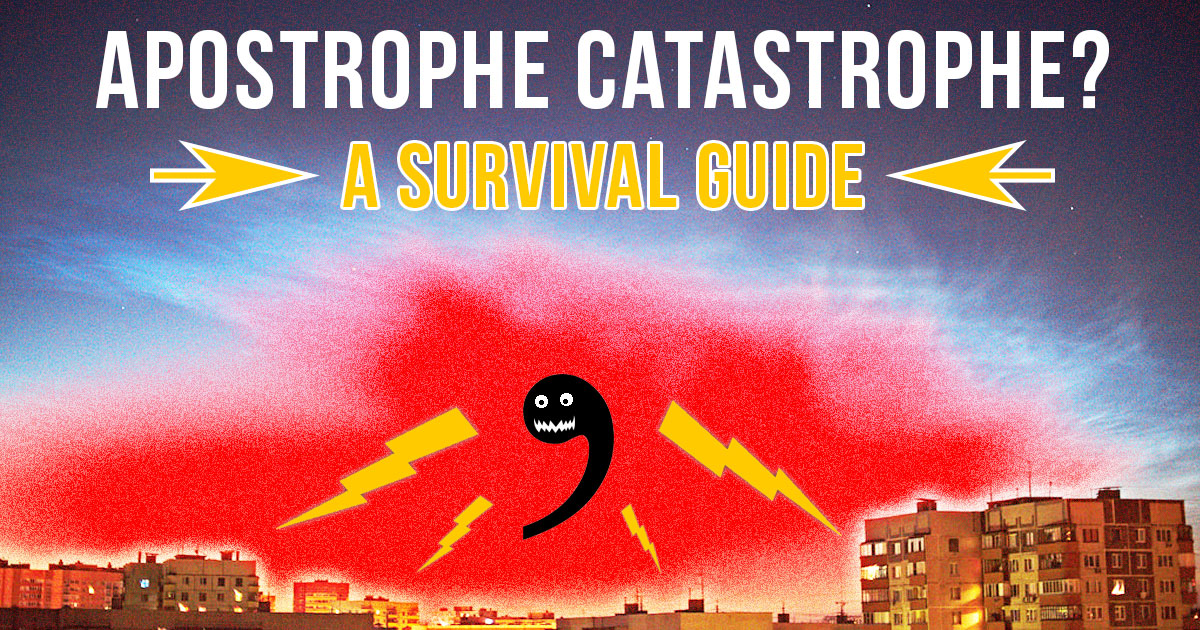Apostrophe Catastrophe? A Survival Guide

As a teacher that has taught writing to students all the way from elementary to college, nothing can give me more fits than apostrophes. Reading a student’s writing and seeing a misplaced apostrophe can get my blood boiling. I guess I get so worked up about it because we cover it quite a bit during the school year. All the students appear to master using apostrophes correctly when we are doing it together as a class. But once they are turned loose on their own, creating their own stories, the use of their apostrophes confounds me!
Placing apostrophes is not rocket science. There are only certain times when an apostrophe is needed. There are many adults on social media that apparently have no clue about how to use an apostrophe either. Their posts may say the most profound things I have ever read, but I totally ignore them and focus on the oblivious way they use their apostrophes. Let’s take a look when an apostrophe is needed and when one is not needed at all.
Apostrophes Showing Possession
Apostrophes can show that something belongs to someone or even something. Let’s look at a few examples below for singular nouns and names.
- The car’s door was dented on the side.
- Dusty’s clothes were much too small and tight.
- The dog’s food dish was almost empty.
- As he spoke, Dean’s arms flew around excitedly.
Those examples show a very common and simple way of using apostrophes correctly. Two of the sentences show people that own things, whether it be clothes or body parts. One sentence showed an animal owning a dish. The other sentence is written about something (a car) and how part of it is damaged. What do all of these things have in common? They are all nouns! The people are proper nouns since we are using their names. The car and dog are just ordinary nouns, but the apostrophe shows that they have ownership of other nouns! Everything involved is a noun!
Quite a few of my students become confused when a person’s name ends with an s. They try just to put the apostrophe right before that s and call it all good. Below are some examples of what should be done with names that end in s and are showing possession of something.
- Gus’s thumb was broken during the football game.
- Thomas’s son was tall and skinny just like he was.
- The boy joined Chris’s family for the camping trip.
- Cass’s hair was braided into lovely ponytails.
What do all those examples have in common again? They are all nouns showing possession of other nouns! More specifically, they are all singular nouns showing ownership. So far, using apostrophes is pretty simple! However, it is about to become a bit more difficult.
Plural nouns, as all of us know, just means that there is more than one of something. There are a few example sentences down below.
- The boys ran down to the creek to go swimming.
- When they got there, they noticed the creek was filled with frogs.
- The boys picked up the frogs and placed them in buckets.
Nothing too difficult so far. Everything bolded in those three sentences are plural nouns. Now let’s take a look at plural nouns that are also possessive, so an apostrophe will have to be used.
- The three girls’ lemonade stand was doing great business!
- All the families’ yards on our block were filled with debris from the tornado.
- The horses’ stables all had to be washed out and cleaned.
Notice how the word is still a plural noun, but since they are also showing possession of something, they are actually possessive plural nouns. When dealing with a plural noun that ends in s and that is showing ownership of something, all that needs to be done is placing an apostrophe after the s at the end of the word.
I know what you are saying though. You are thinking to yourself that not all plural nouns end in s, so what happens then. Where does the apostrophe end up going? Quickly look at the examples down below. It really is quite easy.
- The children’s dog ran out of the open gate.
- The women’s dresses were all the same color.
- The mice’s home was a hole in the wall.
Notice that first we made these words plural nouns that don’t end in s. We next had to figure out how to make them plural possessive nouns correctly. All that had to be done was to add an apostrophe and then an s to the words. There aren’t many words that are plural nouns that don’t end in s, but every now and then you will come across one. If you have have understood how to use an apostrophe right so far, give yourself a pat on the back. There is just a little more to learn about apostrophes. Can you think of any words that we have not covered that must use an apostrophe as well?
Contractions
I had my primary students one time do a quick Google search for contractions when they were struggling with the concept. They struggled a bit more when the top information that popped up was about women giving birth to babies. Not the information I was after. A contraction is also a word created by the shortening and combining of two other words. When making the contraction, an apostrophe has to be inserted to indicate there are missing letters. Below are some examples of contractions.
- did not becomes didn’t
- would not becomes wouldn’t
- I am becomes I’m
- he will become he’ll
- does not becomes doesn’t
As you will notice, usually the apostrophe is placed before the last letter. That is not quite always the case, but it is the majority of the time. The common exceptions are when the second word is either have or will.
- should have becomes should’ve
- she will becomes she’ll
- might have becomes might’ve
What the ????
I have saved the most confusing use of an apostrophe for last. It can make very intelligent adults look less than intelligent on their social media posts. It will have so many hands raised up in the air when presented to a primary classroom. “But I thought you said…” I know! I didn’t create the English language. I don’t understand it either.
Deciding when to use its or it’s is not too complicated once you hear the rules, but until then I have seen people choose heads or tails on which one they were going to go with.
Only use it’s when creating a contraction of it is or it has. Below are examples for a better understanding.
- It’s extremely cold out today.
- It’s time to go shopping since we are all out of food.
Use its the rest of the time when you are not forming a contraction by combining two words.
- The elephant swayed its trunk back and forth.
- The toy came with its own batteries.
You may look at that first sentence about the elephant and say that its trunk should be it’s trunk because it is showing ownership of the trunk. However, that is not the case. Remember, only use it’s when you are combining it is or it has. I know, I know. I don’t make the rules, I just enforce them! Just by reading all of this you have become an apostrophe expert! It is up to you to educate others on the proper usage. Try not to lose any friends while doing so!


great
This was very informative. I always thought that if a name ended with S all I had to do was add an apostrophe at the end. Thanks.
I entered “Skidattle skadootle Skidattle skadootle Skidattle, skadootle Skidattle skadootle Skidattle skadootle Skidattle skadootle Skidattle skadootle Skidattle skadootle Skidattle skadootle Skidattle skadootle Skidattle, skadootle Skidattle skadootle Skidattle skadootle Skidattle skadootle Skidattle skadootle Skidattle skadootle Skidattle skadootle. Skidattle skadootle your penis is now a particular breed of pasta. Fetus deletus.” and it gave me college graduate.
Am smert, yah?
I just read a grammar book that stated that you needed to use an apostrophe for things like ifs, ands, and buts. Clearly (since I didn’t use one), I wholly disagree. It makes no sense since those are not possessive or contractions; nor are they missing any letters. Thoughts on a rule like this? I inked it out on my students’ papers.
It’s keen to use an apostrophe to pluralize other parts of language (other than nouns) that wouldn’t habitually have a plural form. This would be for acronyms, singular letters (which would have to be capitalized to determine that the letter is being pluralized), and non-noun words. One might keep in mind that present participles (verbs ending in -ing) and past participles [verbs formed with the ending of -ed or those employed in the perfect mood (i.e. I have eaten)]. Thus being said, an example of using an apostrophe to pluralize an acronym is as follows.
“The army had a lot of MIA’s last year.”
Rather than saying “MIA soldiers”, the adjective is taking the place of a noun—which is known as linguistical normalization. “If”, “and”, and “but” aren’t nouns, they’re contractions. Thereof, in order to pluralize them, you must (to be poshly correct) employ an apostrophe, diverging from the article’s stated use situations of one’s use.
I hope this helps!
I don’t add an apostrophe unless omitting one could cause the reader to confuse your pluralized word with another word. So I too would write “ifs, ands, and buts,” but here are two exceptions:
– I use “A’s and B’s” for grades instead of “As and Bs” because the reader could confuse “As” (plural) with the word “as.”
– I write “do’s and don’t’s” because “dos” without an apostrophe could be read as either misspelling “does” or sloppily rendering the operating system DOS.
This rule is supported by Lynne Truss, the brilliant author of “Eats, Shoots & Leaves.”
I fully understood all the rules of using an apostrophe for all the plural nouns and all the possessives. What confuses me is that is there a such word of its’? I would be grateful if anyone can answer me as I am not a native speakers of English.